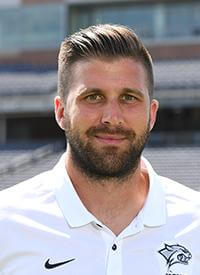College Athletics Recruiting
CVCA’s college recruiting coordinator is here to help navigate our student-athletes and families through the recruiting process. We want our students who are passionate about their sport and want to continue their athletic careers at the next level to have a person to help inform and educate them about how to do that.
Nick Thompson, College Recruiting Coordinator
Having worked in college athletics for the better part of 10 years, I feel that I can be an asset to many of our athletes and families at CVCA who don’t know how to navigate the world of college athletics. Through my extensive experience recruiting and working with a number of student-athletes through the process, I am eager to be a resource to our student-athletes and look forward to helping them achieve their goal of being a college athlete.

Recruiting Process FAQ's
There are a number of ways this can happen. The first way is when a college coach reaches out to you specifically and mentions that they would like to talk to you about their college/university. Another way this can happen, you can construct an email talking about who you are and why you think you would be a good fit for whatever college/university you are contacting and be proactive about the school you would like to play for. It doesn’t mean they will start recruiting you, but it may be a way to gather more information and find out the next steps.
There are 3 divisions within the NCAA (Division 1-3). Typically, you would assume all D1 teams are better than all D2, which are better than all D3…. That is not the case!
There are Division 3 teams that are better than Division 1 teams.
The division schools are in largely depends on Finances, Location, and Preference. Most D1 schools have larger football or basketball programs and offer a greater amount of sports in general.
NCAA Divisions 1 and 2 offer athletic scholarships. NCAA Division 3 does not.
NAIA and Jr. College schools can offer scholarships, as well.
NAIA is similar to the NCAA. It is an association that offers an alternative for student-athletes to larger colleges or universities. While NAIA schools may not be as high-profile as other NCAA schools, they offer a lot of athletic scholarship opportunities for student-athletes.
Jr College is more of a route a student-athlete may choose to go if they need to work on their academics. It is a place they can go to improve academically and still participate in college athletics. Many student-athletes start at Jr. College and go on to NCAA schools and have outstanding athletic careers.
The recruiting cycle differs from sport to sport and even gender to gender within the sport (for example, top level men’s soccer’s main recruiting time is Junior year, while top level women’s soccer’s main recruiting time is Sophomore year). There are a lot of factors colleges/universities are working with when going through a recruiting period. For some sports, you should be reaching out even as early as your Freshman year of high school, if you have aspirations of playing at the highest collegiate level. But, you could also reach out during your senior year and have the opportunity to be recruited and play somewhere.
Early is better than late to get the process started. But there are certain times, depending on the sport and gender (men’s or women’s) that play a factor in the best time to reach out to schools.
In order to be recruited, the schools you are interested in need to see you play. That can happen a number of ways, but if you have a highlight video it makes it easier for schools to get an idea of the type of athlete you are. So, yes you should make a video and it should be 3-5 minutes long.
